Dissipative Soliton Mode-Locked Erbium-Doped Fiber Laser Using Nb2AlC Nanomaterial Saturable Absorber
Abstract
1. Introduction
2. Nb2AlC Preparation and Characterization
3. Experimental Configuration
4. Results and Discussion
5. Conclusions
Author Contributions
Funding
Data Availability Statement
Acknowledgments
Conflicts of Interest
References
- Dudley, J.M. Light, lasers, and the Nobel Prize. Adv. Photonics 2020, 2, 050501. [Google Scholar] [CrossRef]
- Rawicz, A.H. Theodore Harold Maiman and the invention of laser. In Proceedings of the Photonics, Devices, and Systems IV, Prague, Czech Republic, 27–29 September 2008; pp. 39–46. [Google Scholar]
- Al-Zhrani, S.; Bedaiwi, N.M.; El-Ramli, I.F.; Barasheed, A.Z.; Abduldaiem, A.; Al-Hadeethi, Y.; Umar, A. Underwater optical communications: A brief overview and recent developments. Eng. Sci. 2021, 16, 146–186. [Google Scholar] [CrossRef]
- Tong, L. Micro/nanofibre optical sensors: Challenges and prospects. Sensors 2018, 18, 903. [Google Scholar] [CrossRef] [PubMed]
- Vicidomini, G.; Bianchini, P.; Diaspro, A. STED super-resolved microscopy. Nat. Methods 2018, 15, 173–182. [Google Scholar] [CrossRef]
- Jansen, F.; Kanal, F.; Kahmann, M.; Tan, C.; Diekamp, H.; Scelle, R.; Budnicki, A.; Sutter, D. Fiber laser platform for highest flexibility and reliability in industrial femtosecond micromachining: TruMicro Series 2000. In Proceedings of the Fiber Lasers XV: Technology and Systems, San Francisco, CA, USA, 27 January–1 February 2018; pp. 456–462. [Google Scholar]
- Enikeev, D.; Taratkin, M.; Klimov, R.; Alyaev, Y.; Rapoport, L.; Gazimiev, M.; Korolev, D.; Ali, S.; Akopyan, G.; Tsarichenko, D. Thulium-fiber laser for lithotripsy: First clinical experience in percutaneous nephrolithotomy. World J. Urol. 2020, 38, 3069–3074. [Google Scholar] [CrossRef] [PubMed]
- Wu, D.C.; Goldman, M.P.; Wat, H.; Chan, H.H. A systematic review of picosecond laser in dermatology: Evidence and recommendations. Lasers Surg. Med. 2021, 53, 9–49. [Google Scholar] [CrossRef]
- Dai, L.; Huang, Z.; Huang, Q.; Zhao, C.; Rozhin, A.; Sergeyev, S.; Al Araimi, M.; Mou, C. Carbon nanotube mode-locked fiber lasers: Recent progress and perspectives. Nanophotonics 2021, 10, 749–775. [Google Scholar] [CrossRef]
- Zhang, S.; Li, Z.; Xing, F. Review of polarization optical devices based on graphene materials. Int. J. Mol. Sci. 2020, 21, 1608. [Google Scholar] [CrossRef]
- Zhou, R.; Ullah, K.; Hussain, N.; Fadhali, M.M.; Yang, S.; Lin, Q.; Zubair, M.; Iqbal, M.F. Recent advances in photonics of three-dimensional Dirac semimetal Cd3As2. Adv. Photonics Nexus 2022, 1, 024001. [Google Scholar] [CrossRef]
- Zhang, A.; Wang, Z.; Ouyang, H.; Lyu, W.; Sun, J.; Cheng, Y.; Fu, B. Recent progress of two-dimensional materials for ultrafast photonics. Nanomaterials 2021, 11, 1778. [Google Scholar] [CrossRef]
- You, J.; Bongu, S.; Bao, Q.; Panoiu, N. Nonlinear optical properties and applications of 2D materials: Theoretical and experimental aspects. Nanophotonics 2019, 8, 63–97. [Google Scholar] [CrossRef]
- Haris, H.; Muhammad, A.; Tan, S.; Markom, A.; Harun, S.; Hasnan, M.M.; Saad, I. Generation of Kelly and dip type sidebands soliton employing Topological insulator (Bi2Te3) as saturable absorber. Infrared Phys. Technol. 2022, 123, 104154. [Google Scholar] [CrossRef]
- Mohanraj, J.; Velmurugan, V.; Sivabalan, S. Transition metal dichalcogenides based saturable absorbers for pulsed laser technology. Opt. Mater. 2016, 60, 601–617. [Google Scholar] [CrossRef]
- Markom, A.; Tan, S.; Muhammad, A.; Paul, M.C.; Dhar, A.; Das, S.; Latiff, A.; Harun, S. Dark pulse mode-locked fibre laser with zirconia-based erbium-doped fibre (Zr-EDF) and Black phosphorus saturable absorber. Optik 2020, 223, 165635. [Google Scholar] [CrossRef]
- Liu, G.; Zhang, F.; Wu, T.; Li, Z.; Zhang, W.; Han, K.; Xing, F.; Man, Z.; Ge, X.; Fu, S. Single-and dual-wavelength passively mode-locked erbium-doped fiber laser based on antimonene saturable absorber. IEEE Photonics J. 2019, 11, 1503413. [Google Scholar] [CrossRef]
- Li, P.; Chen, Y.; Yang, T.; Wang, Z.; Lin, H.; Xu, Y.; Li, L.; Mu, H.; Shivananju, B.N.; Zhang, Y. Two-dimensional CH3NH3PbI3 perovskite nanosheets for ultrafast pulsed fiber lasers. ACS Appl. Mater. Interfaces 2017, 9, 12759–12765. [Google Scholar] [CrossRef] [PubMed]
- Jhon, Y.I.; Koo, J.; Anasori, B.; Seo, M.; Lee, J.H.; Gogotsi, Y.; Jhon, Y.M. Metallic MXene saturable absorber for femtosecond mode-locked lasers. Adv. Mater. 2017, 29, 1702496. [Google Scholar] [CrossRef]
- Hadi, M.; Kelaidis, N.; Naqib, S.; Chroneos, A.; Islam, A. Mechanical behaviors, lattice thermal conductivity and vibrational properties of a new MAX phase Lu2SnC. J. Phys. Chem. Solids 2019, 129, 162–171. [Google Scholar] [CrossRef]
- Gencer, A.; Surucu, G. Electronic and lattice dynamical properties of Ti2SiB MAX phase. Mater. Res. Express 2018, 5, 076303. [Google Scholar] [CrossRef]
- Qureshi, M.W.; Ali, M.; Ma, X. Screen the thermomechanical and optical properties of the new ductile 314 MAX phase boride Zr3CdB4: A DFT insight. J. Alloy. Compd. 2021, 877, 160248. [Google Scholar] [CrossRef]
- Eklund, P.; Beckers, M.; Jansson, U.; Högberg, H.; Hultman, L. The Mn+1AXn phases: Materials science and thin-film processing. Thin Solid Film. 2010, 518, 1851–1878. [Google Scholar] [CrossRef]
- Maduraiveeran, G.; Sasidharan, M.; Ganesan, V. Electrochemical sensor and biosensor platforms based on advanced nanomaterials for biological and biomedical applications. Biosens. Bioelectron. 2018, 103, 113–129. [Google Scholar] [CrossRef]
- Yahia, I.; Mohammed, M. Facile synthesis of graphene oxide/PVA nanocomposites for laser optical limiting: Band gap analysis and dielectric constants. J. Mater. Sci. Mater. Electron. 2018, 29, 8555–8563. [Google Scholar] [CrossRef]
- Chiu, J.-C.; Chang, C.-M.; Hsieh, B.-Z.; Lin, S.-C.; Yeh, C.-Y.; Lin, G.-R.; Lee, C.-K.; Lin, J.-J.; Cheng, W.-H. Pulse shortening mode-locked fiber laser by thickness and concentration product of carbon nanotube based saturable absorber. Opt. Express 2011, 19, 4036–4041. [Google Scholar] [CrossRef] [PubMed]
- Cheng, L.; Yuan, Y.; Liu, C.; Cao, X.; Su, J.; Zhang, X.; Zhang, H.; Zhao, H.; Xu, M.; Li, J. Linear and nonlinear optical properties modulation of Sb2Te3/GeTe bilayer film as a promising saturable absorber. Results Phys. 2019, 13, 102282. [Google Scholar] [CrossRef]
- Ahmad, H.; Azri, M.; Ramli, R.; Samion, M.; Yusoff, N.; Lim, K. 2 μm passively mode-locked thulium-doped fiber lasers with Ta2AlC-deposited tapered and side-polished fibers. Sci. Rep. 2021, 11, 21278. [Google Scholar] [CrossRef]
- Sun, G.; Feng, M.; Zhang, K.; Wang, T.; Li, Y.; Han, D.; Li, Y.; Song, F. Q-Switched and Mode-Locked Er-doped fiber laser based on MAX phase Ti2AlC saturable absorber. Results Phys. 2021, 26, 104451. [Google Scholar] [CrossRef]
- Kwon, S.-y.; Lee, J.; Lee, J.H. Passive mode-locking by a Ti2AlN saturable absorber in 1.5 µm region. Optik 2022, 251, 168364. [Google Scholar] [CrossRef]
- Najm, M.M.; Al-Hiti, A.S.; Nizamani, B.; Zhang, P.; Arof, H.; Rosol, A.H.A.; Yasin, M.; Harun, S.W. Ultrafast laser soliton mode-locked at 1.5 μm region based on Cr2AlC MAX phase as a saturable absorber. Opt. Eng. 2021, 60, 066116. [Google Scholar] [CrossRef]
- Jafry, A.; Kasim, N.; Rusdi, M.; Rosol, A.; Yusoff, R.; Muhammad, A.; Nizamani, B.; Harun, S. MAX phase based saturable absorber for mode-locked erbium-doped fiber laser. Opt. Laser Technol. 2020, 127, 106186. [Google Scholar] [CrossRef]
- Omar, S.; Rosol, A.; Jafry, A.; Zulkipli, N.F.; Jusoh, Z.; Musa, B.; Yasin, M.; Harun, S.W. Ti3AlC2 MAX phase thin film as saturable absorber for generating soliton mode-locked fiber laser. Optik 2021, 245, 167767. [Google Scholar] [CrossRef]
- Jafry, A.A.A.; Rosol, A.H.A.; Kasim, N.; Muhammad, A.R.; Rulaningtyas, R.; Yasin, M.; Harun, S.W. Soliton mode-locked pulse generation with a bulk structured MXene Ti3AlC2 deposited onto a D-shaped fiber. Appl. Opt. 2020, 59, 8759–8767. [Google Scholar] [CrossRef]
- Hu, Y.; Yang, X.; Li, L.; Gao, Q.; Li, S.; Wu, Z.; Yang, Y.; Cui, H.; Zhou, S. A passively Q-switched operation of Tm: YAP laser with a Nb2AlC-based saturable absorber. Optik 2022, 256, 168743. [Google Scholar] [CrossRef]
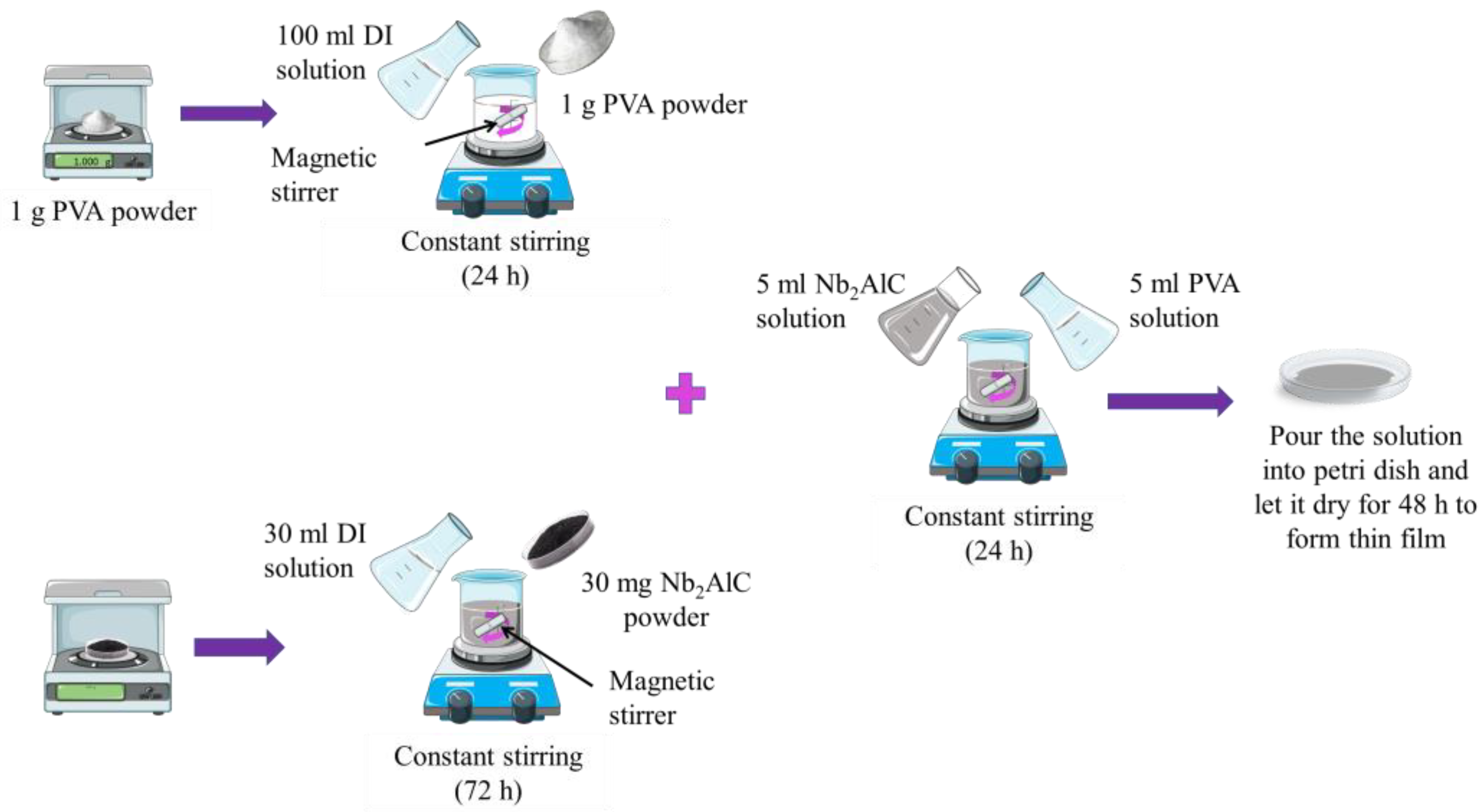

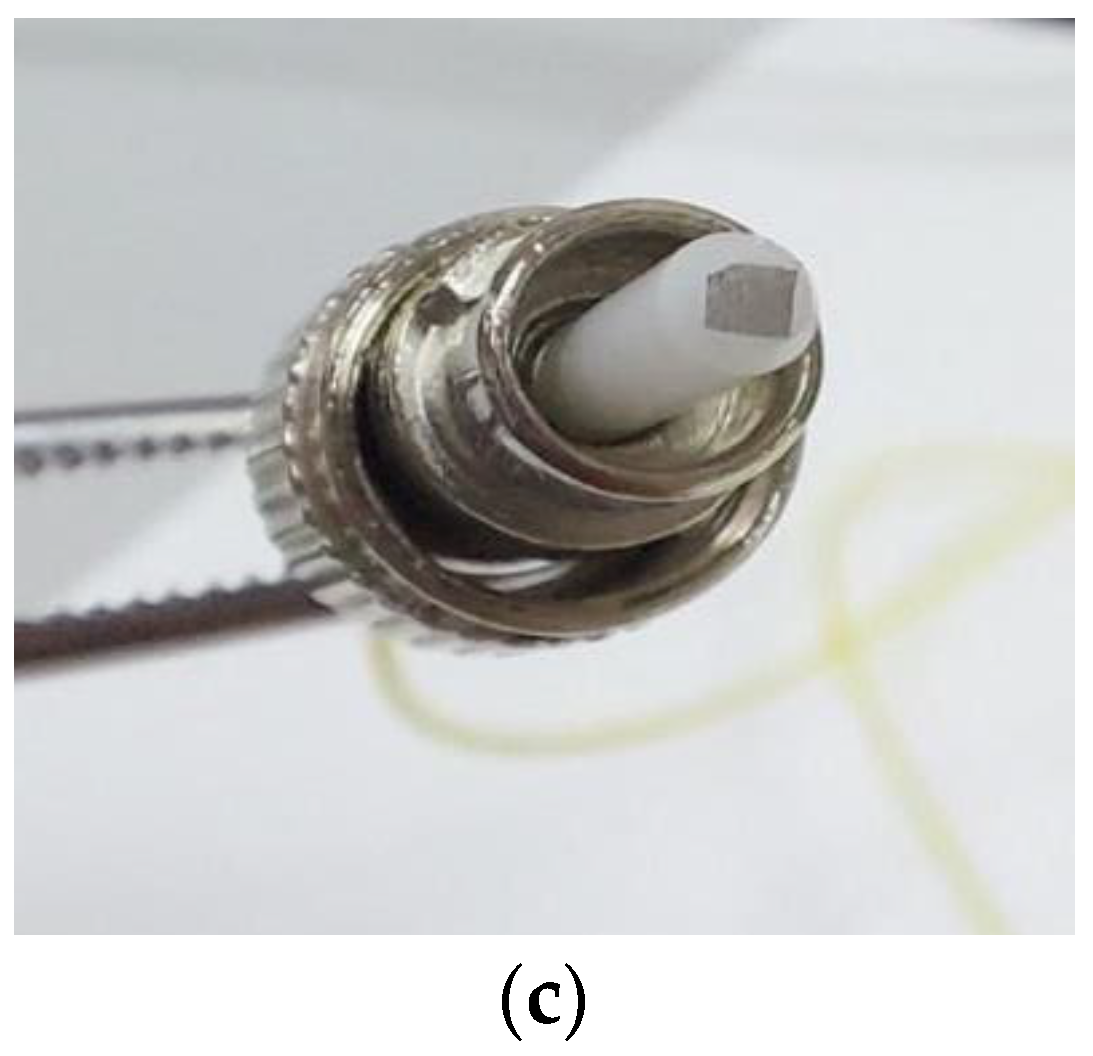
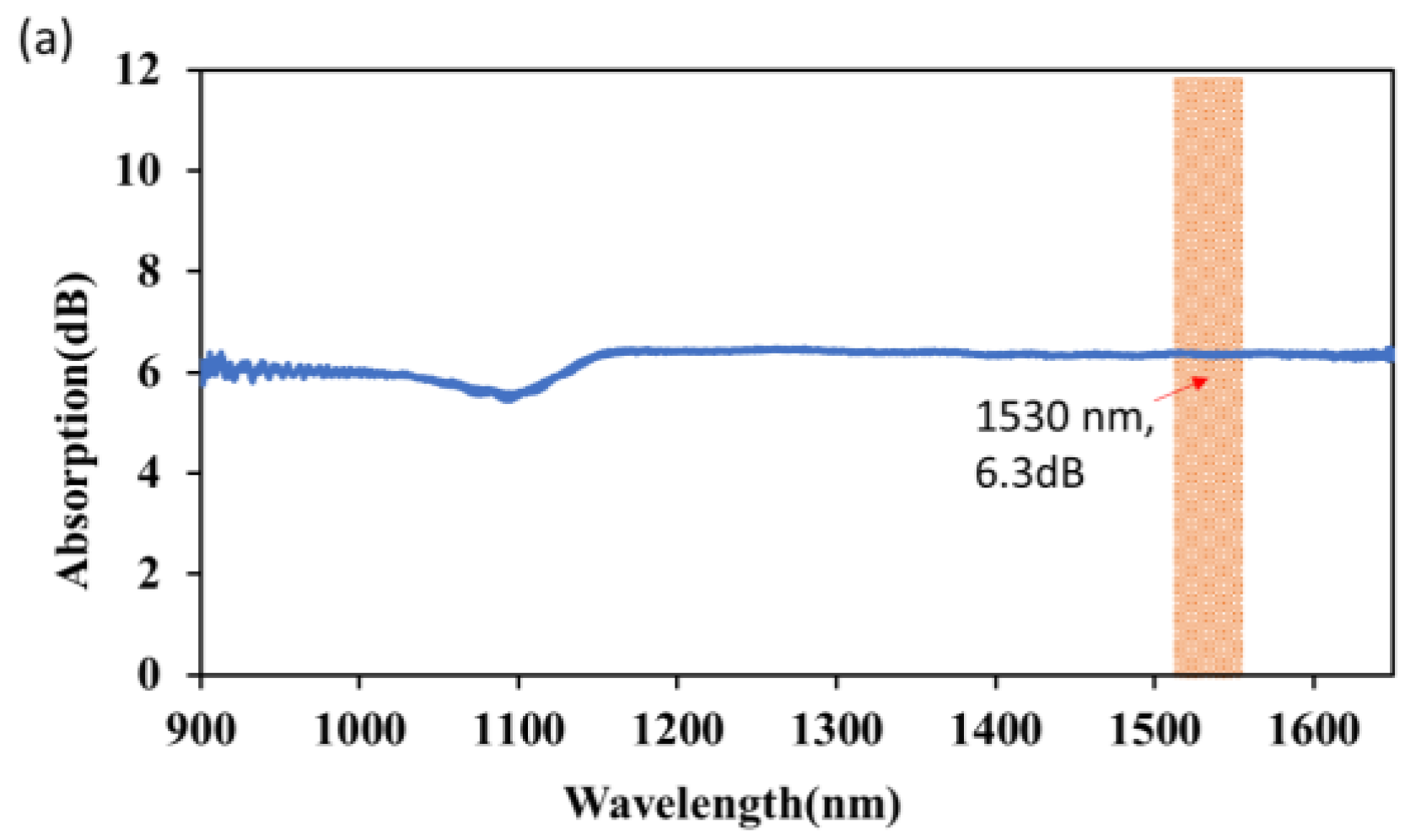
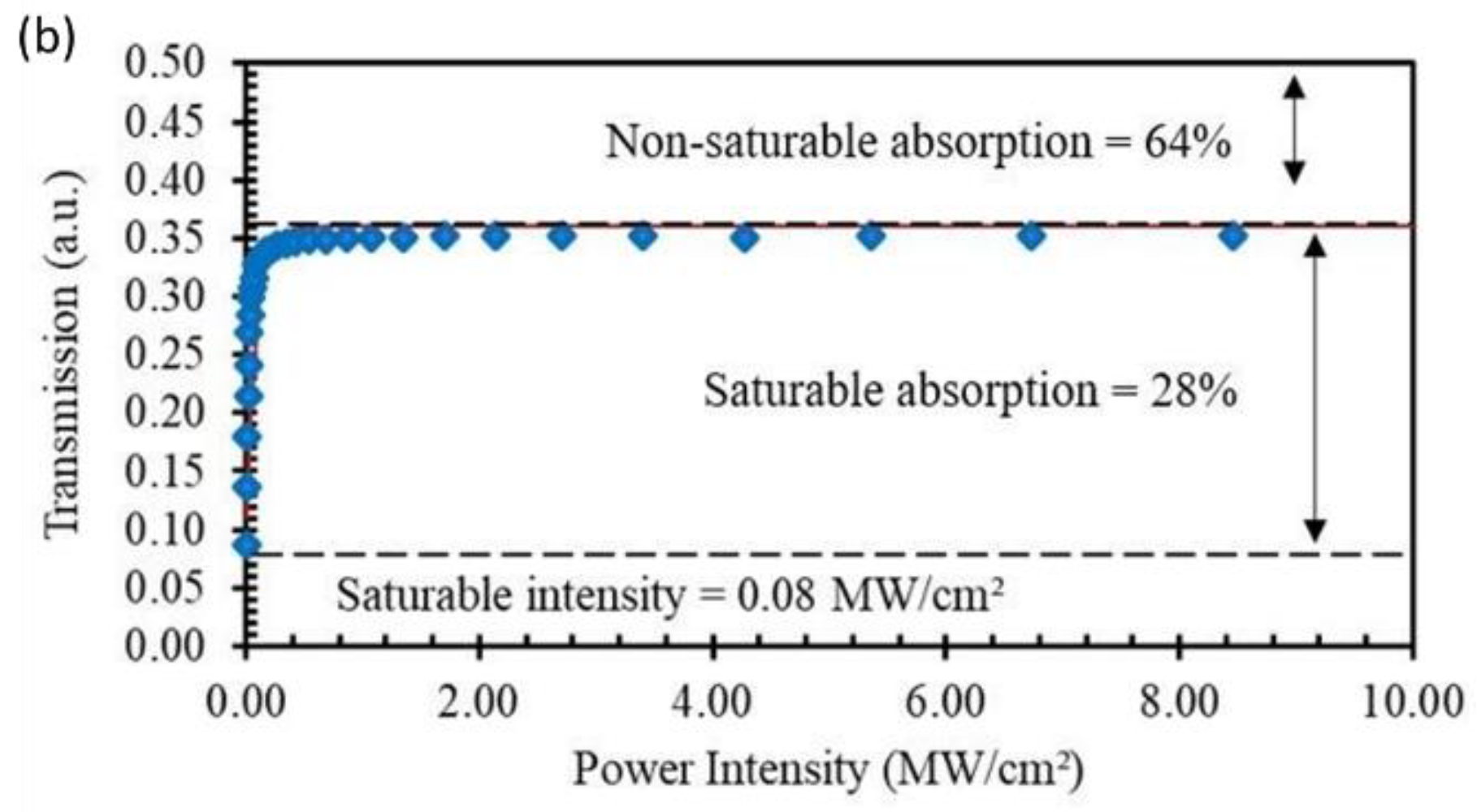
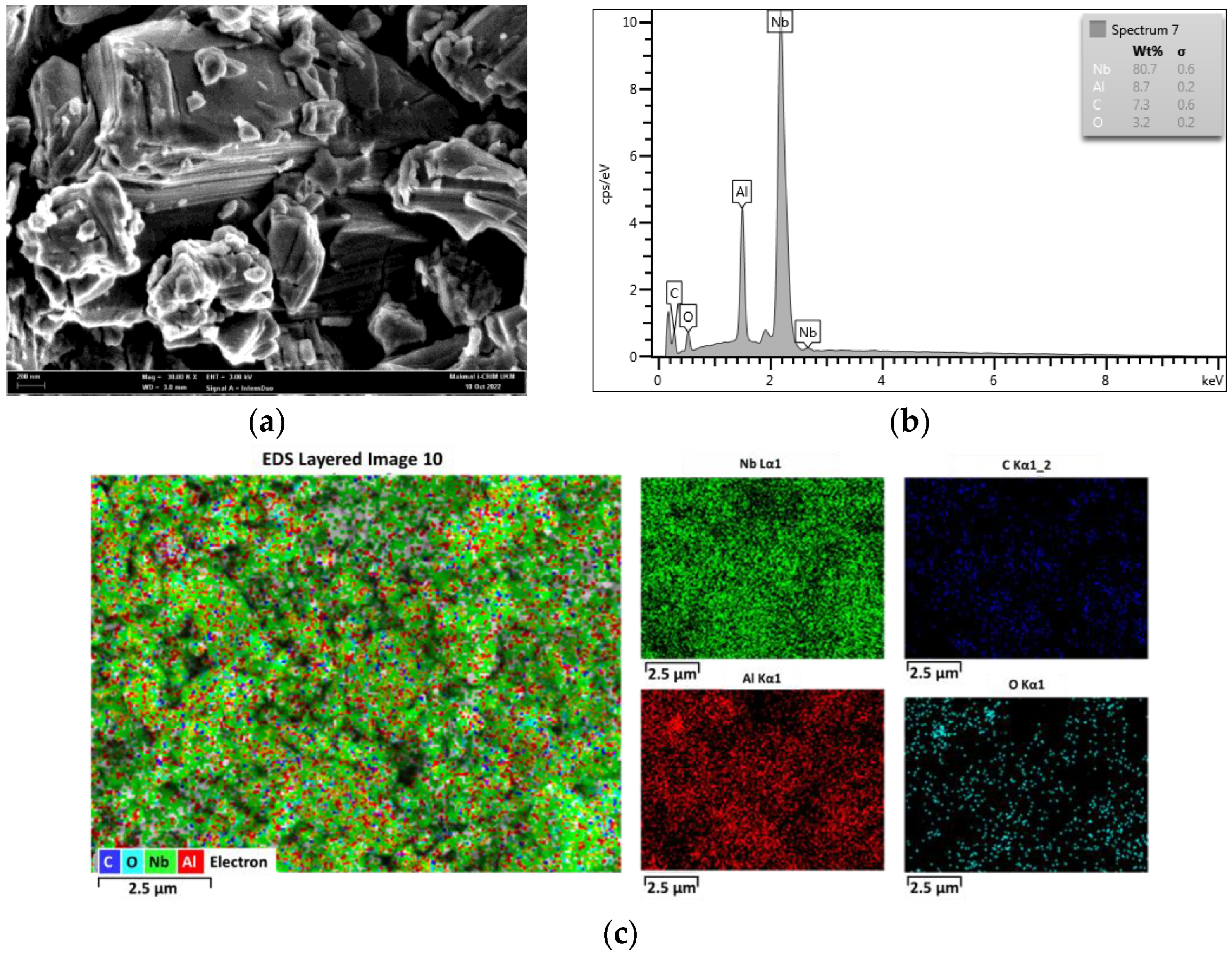
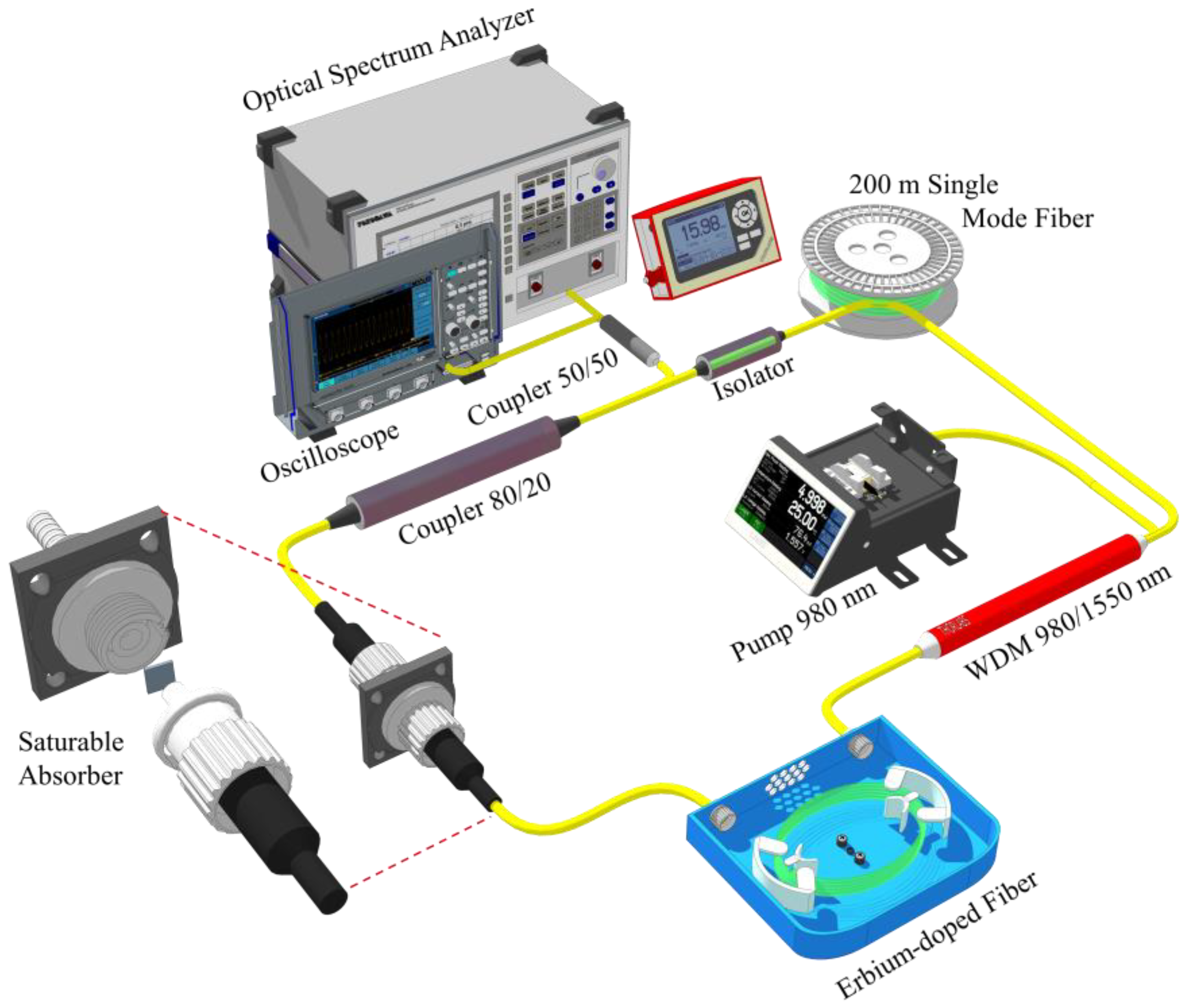
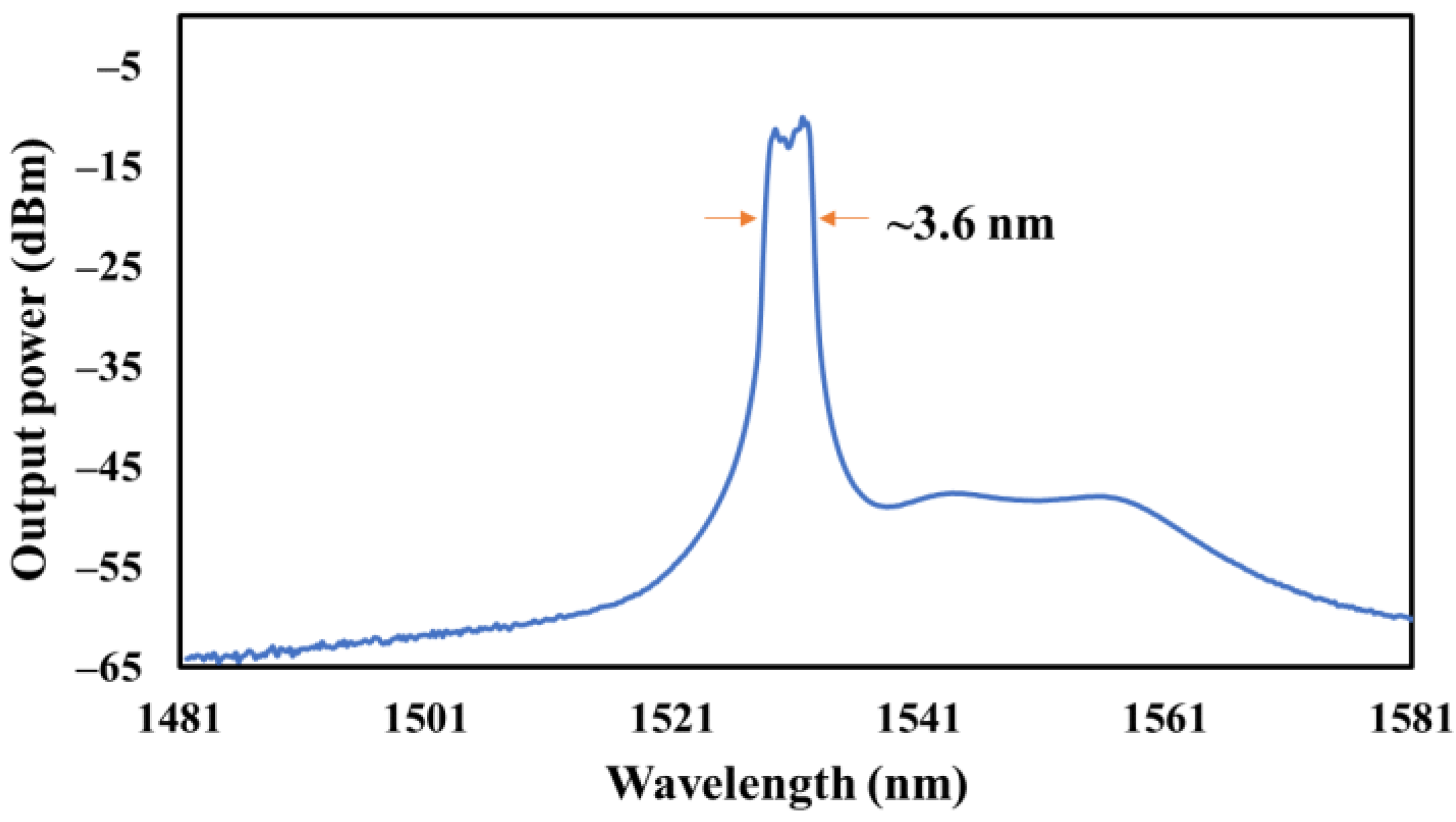
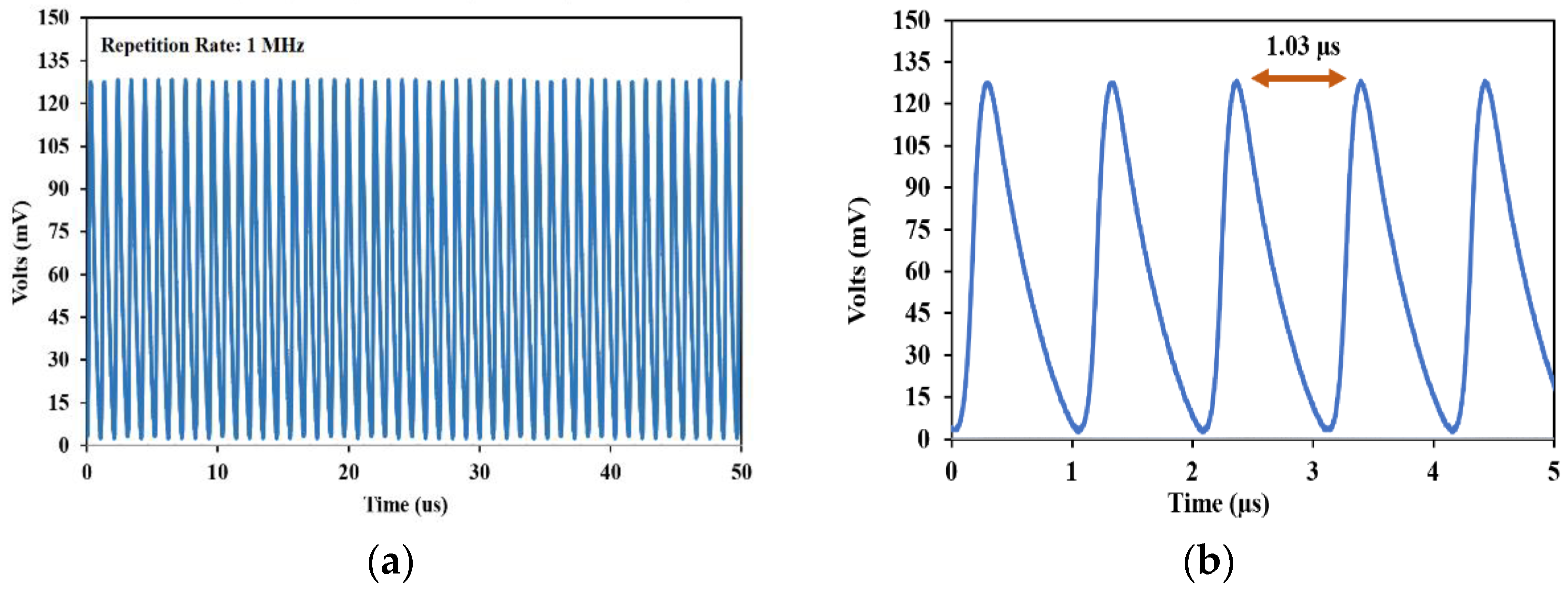

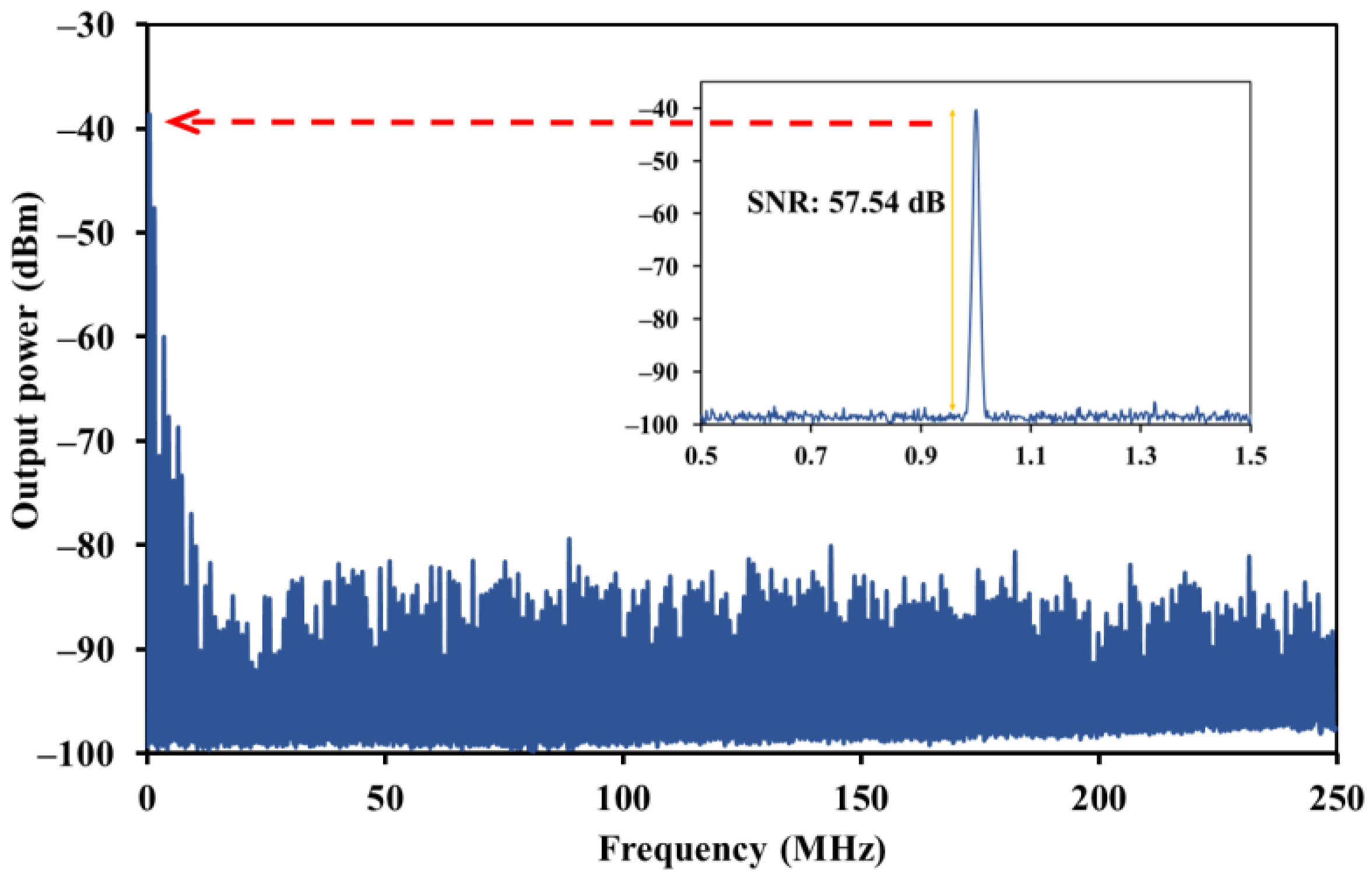
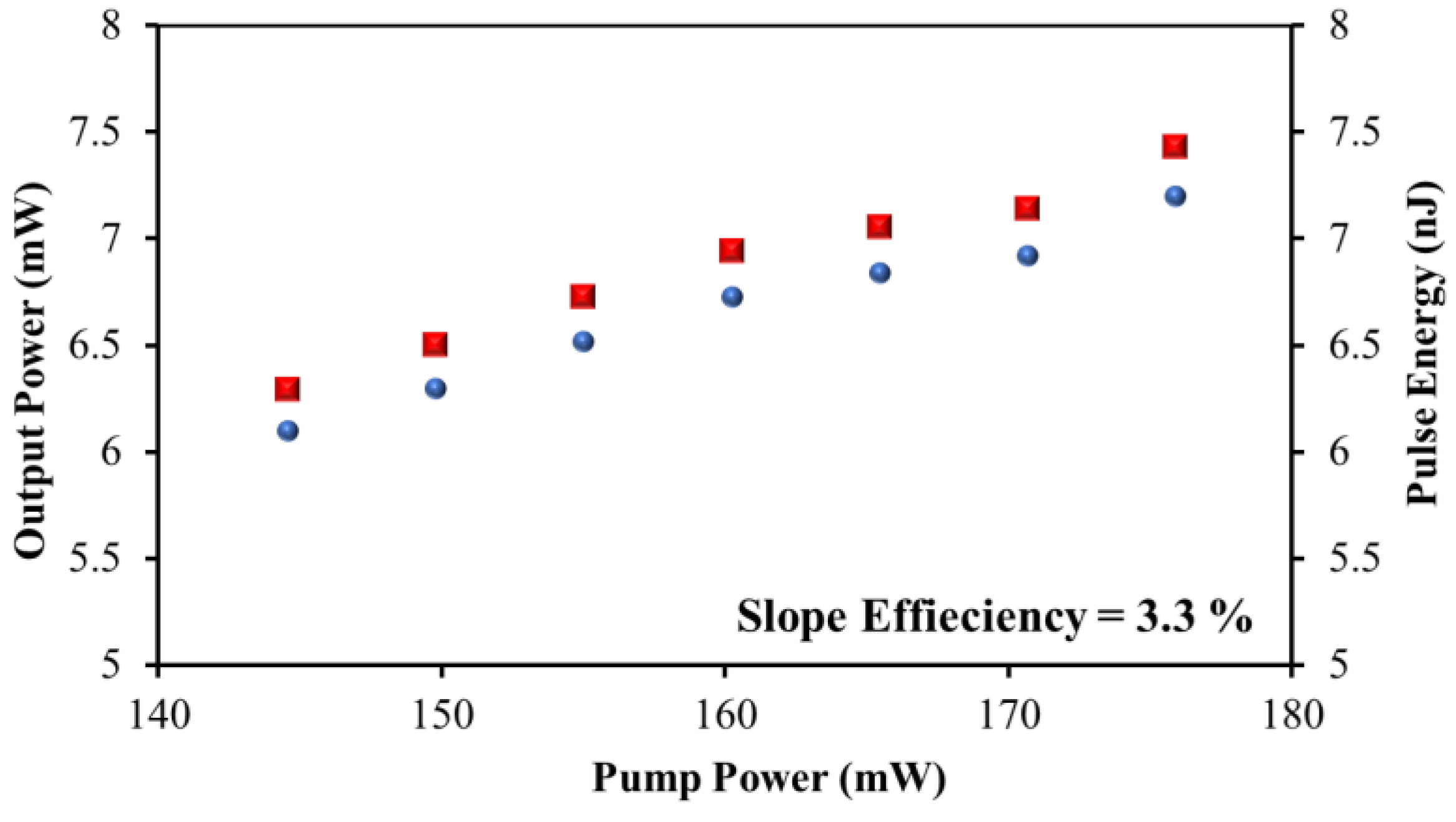
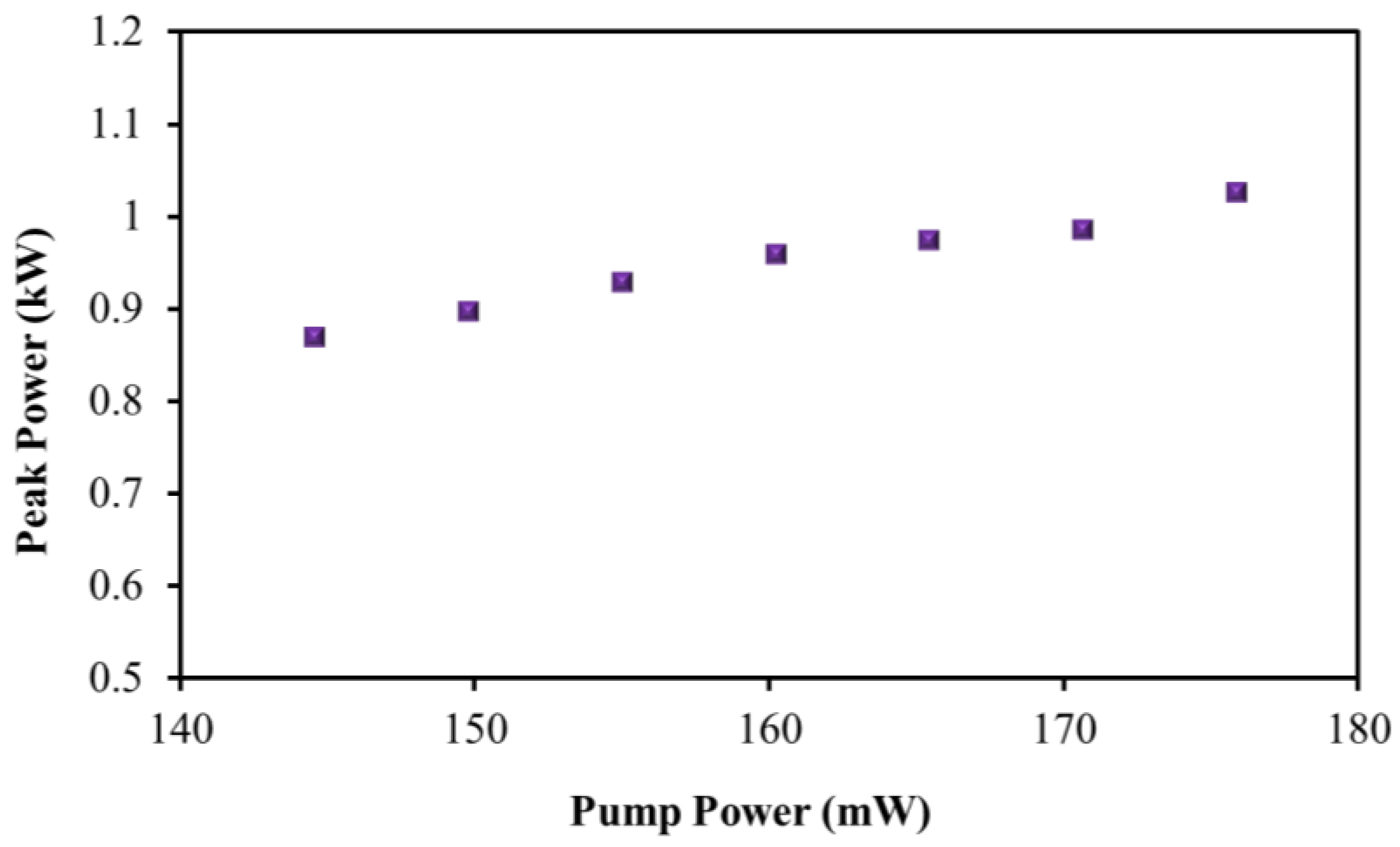
| SA | Integration Method | Center Wavelength (nm) | Threshold (mW) | Repetition Rate (MHz) | Pulse Energy (nJ) | Pulse Width (ps) | Type of Pulse | Ref. |
|---|---|---|---|---|---|---|---|---|
| Ta2AlC | Tapered | 1937 | 245 | 10.73 | - | 1.678 | Soliton Mode-locked | [28] |
| Side polished fiber (SPF) | 1931 | 351 | 9.52 | - | 1.743 | |||
| Arc-shaped | 1929 | 380 | 10.16 | - | 1.817 | |||
| Ti2AlC | Thin film | 1559 | 220 | 5.16 | - | 0.68 | Soliton Mode-locked | [29] |
| Ti2AlN | Thin film | 1557.5 | 150 | 14.8 | 16.2 | 5.04 | Mode-locked | [30] |
| Cr2AlC | Thin film | 1559 | 121.69 | 1 | 0.91 | 4.45 | Soliton mode-locked | [31] |
| Ti3AlC2 | Thin film | 1557.77 | 103.6 | 1.887 | 8.16 | 3.68 | Mode-locked | [32] |
| Ti3AlC2 | Thin film | 1559.7 | 66.3 | 1.8 | 4.46 | 5.02 | Soliton mode-locked | [33] |
| Ti3AlC2 | D-shaped | 1557.63 | 21 | 1.89 | 8.14 | 2.21 | Soliton mode-locked | [34] |
| Nb2AlC | Thin-film | 1987.2 | 10340/10.3 W | 0.135 | 11540/11.54 µJ | 850000/850 ns | Q-switched | [35] |
| Nb2AlC | Thin film | 1530 | 144.57 | 1 | 7.43 | 6.375 | Dissipative soliton mode-locked | This work |
Disclaimer/Publisher’s Note: The statements, opinions and data contained in all publications are solely those of the individual author(s) and contributor(s) and not of MDPI and/or the editor(s). MDPI and/or the editor(s) disclaim responsibility for any injury to people or property resulting from any ideas, methods, instructions or products referred to in the content. |
© 2023 by the authors. Licensee MDPI, Basel, Switzerland. This article is an open access article distributed under the terms and conditions of the Creative Commons Attribution (CC BY) license (https://creativecommons.org/licenses/by/4.0/).
Share and Cite
Markom, A.M.; Ghafar, N.A.M.A.; Batumalay, M.; Yusof, Y.; Rosol, A.H.A.; Zulkipli, N.F.; Muhammad, A.R.; Haris, H.; Saad, I.; Harun, S.W. Dissipative Soliton Mode-Locked Erbium-Doped Fiber Laser Using Nb2AlC Nanomaterial Saturable Absorber. Nanomaterials 2023, 13, 810. https://doi.org/10.3390/nano13050810
Markom AM, Ghafar NAMA, Batumalay M, Yusof Y, Rosol AHA, Zulkipli NF, Muhammad AR, Haris H, Saad I, Harun SW. Dissipative Soliton Mode-Locked Erbium-Doped Fiber Laser Using Nb2AlC Nanomaterial Saturable Absorber. Nanomaterials. 2023; 13(5):810. https://doi.org/10.3390/nano13050810
Chicago/Turabian StyleMarkom, Arni Munira, Nurul Athirah Mohamad Abdul Ghafar, Malathy Batumalay, Yusrina Yusof, Ahmad Haziq Aiman Rosol, Nur Farhanah Zulkipli, Ahmad Razif Muhammad, Hazlihan Haris, Ismail Saad, and Sulaiman Wadi Harun. 2023. "Dissipative Soliton Mode-Locked Erbium-Doped Fiber Laser Using Nb2AlC Nanomaterial Saturable Absorber" Nanomaterials 13, no. 5: 810. https://doi.org/10.3390/nano13050810
APA StyleMarkom, A. M., Ghafar, N. A. M. A., Batumalay, M., Yusof, Y., Rosol, A. H. A., Zulkipli, N. F., Muhammad, A. R., Haris, H., Saad, I., & Harun, S. W. (2023). Dissipative Soliton Mode-Locked Erbium-Doped Fiber Laser Using Nb2AlC Nanomaterial Saturable Absorber. Nanomaterials, 13(5), 810. https://doi.org/10.3390/nano13050810







